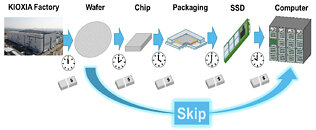Thursday, July 2nd 2020

Kioxia Plans for Wafer-Level SSD
Wafer-scale design is getting popular it seems. Starting from the wafer-scale engine presented by Cerebras last year, which caused quite the shakeup in the industry, it seems that this design approach might be more useful than anyone thought. During VLSI Symposium 2020, Shigeo Oshima, Chief Engineer at Kioxia, had a presentation about new developments in SSD designs and implementations. What was one of the highlights of the presentation was the information that Kioxia is working on, was a technology Kioxia is referring to as wafer-level SSD.
The NAND chips used in SSDs would no longer be cut from the wafer and packaged separately. Instead, the wafer itself would represent the SSD. This is a similar approach Cerebras used with its wafer-scale engine AI processor. What would be gains of this approach compared to traditional methods of cutting up NAND chips and packaging them separately you might wonder? Well, for starters you wouldn't need to cut the wafer, package individual memory chips, and build the SSD out of them. Those steps could be skipped and there would be some cost savings present. And imagine if you decide to do wafer stacking. You could build super scaling SSDs with immense performance capable of millions of IOPS. However, for now, this is only a concept and it is just in early development. There is no possibility to find it in a final product anytime soon.
Source:
Hardwareluxx.de
The NAND chips used in SSDs would no longer be cut from the wafer and packaged separately. Instead, the wafer itself would represent the SSD. This is a similar approach Cerebras used with its wafer-scale engine AI processor. What would be gains of this approach compared to traditional methods of cutting up NAND chips and packaging them separately you might wonder? Well, for starters you wouldn't need to cut the wafer, package individual memory chips, and build the SSD out of them. Those steps could be skipped and there would be some cost savings present. And imagine if you decide to do wafer stacking. You could build super scaling SSDs with immense performance capable of millions of IOPS. However, for now, this is only a concept and it is just in early development. There is no possibility to find it in a final product anytime soon.

15 Comments on Kioxia Plans for Wafer-Level SSD
"Hey Joe, did you fed the waffle to the server yet?"
"Nah, he's already full!"
*(not considering what solution they are going to come-up with to deliver for the controller, power delivery, power backup, bus/connectors and other regular stuff hot-swap storage solutions have had since the start)
What I presume is happening is that a single die now represents the controller, the DRAM cache, and the voltage step-down circuitry, but it still needs to be packaged into a form-factor that can be plugged into a motherboard.
They should just glue it to Cerebras's wafer and just make it a gigantic L4 cache, haha
Possibly they'll do this for one-off high-budget supercomputers but I can't see this becoming a commodity item for a while.